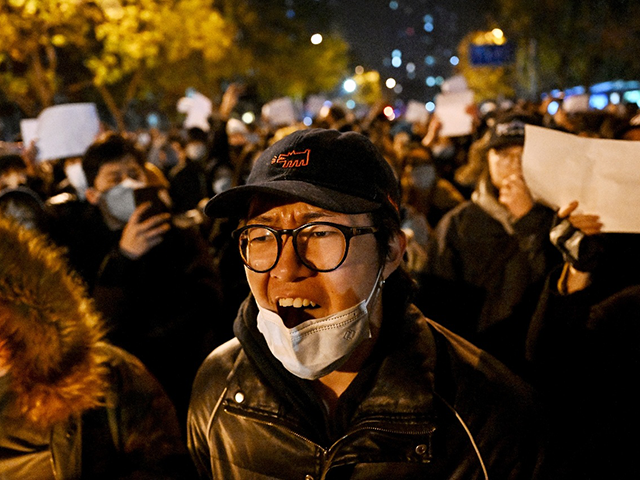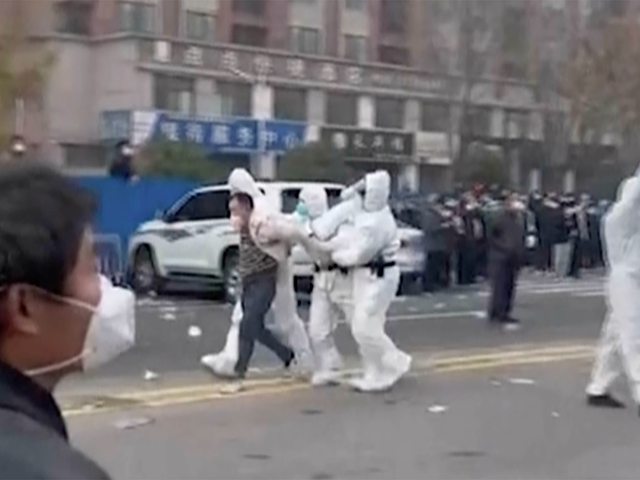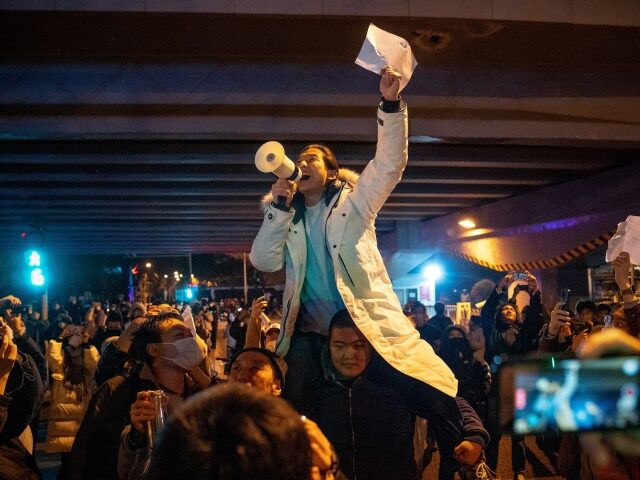“Years of mounting government repression” is driving a growing, and unusually interconnected, protest movement within China fueled only in part by opposition to coronavirus lockdowns, Michael Abramowitz, the president of Freedom House, told Breitbart News.
Abramowitz suggested that the eruption of protests in China’s major cities last week – most prominent in the national capital, Beijing, and major cities Shanghai, Guangzhou, Chengdu, and Zhengzhou – was “likely just the tip of the iceberg,” as China’s gigantic internet censorship apparatus makes it impossible for news of many smaller protests in less populated areas to make it out of the country.
The Freedom House president responded to questions from Breitbart News this weekend on the origin, nature, and potential impact of the protests last week. Opposition to the Communist Party’s “zero-Covid” policy, which relies heavily on abruptly locking down major cities and imprisoning thousands of people in poorly administered quarantine camps, appeared to be the driving force behind the protests. Immediately prior to the protests spreading across the nation’s largest cities, the poor handling of a fire in Urumqi, the capital of the occupied East Turkistan region where the Communist Party is currently committing genocide against its indigenous Muslim population, appeared to be the seed of much public disgust. The Urumqi fire is believed to have caused between ten to 40 deaths, including children, because the building in question was locked down as per “zero-Covid” policy and firefighters could not get close enough to do their jobs.
Many, however, appeared to be expressing opposition to the Party’s repression generally, choosing to hold up blank pieces of paper – representing what they are allowed to legally say in the country – as an expression of dissent.
Shortly before the late November protests, Freedom House launched a new initiative called the China Dissent Monitor, a database meant to document and make searchable the growing number of protests and general anti-government public events in the country. Freedom House noted that public repudiation of the government had become so common it was necessary for the organization to establish a project to track it all.
“Contrary to what the CCP [Chinese Communist Party] would like the world to believe, these protests are not the only recent instance of people using public acts of dissent to speak out in China,” Abramowitz told Breitbart News. “Between June and October of this year, Freedom House’s China Dissent Monitor tracked at least 822 public expressions of dissent, with incidents scattered among 27 provinces.”

Protesters march along a street during a rally for the victims of a deadly fire as well as a protest against China’s harsh Covid-19 restrictions in Beijing on November 28, 2022. (Noel CELIS / AFP)
“Dozens of protests attended by thousands of people might seem small in a country with 1.5 billion, but considering how little on-the-ground reporting makes it through the Great Firewall, what we’ve seen this week is likely just the tip of the iceberg,” he explained.
The Chinese coronavirus civil rights abuses, he continued, were the focus of the latest protests, but “they’re also an expression of the Chinese people’s broader frustration with years of mounting government repression, which has only worsened since the outbreak of COVID-19.”
“Demands related to ending zero-COVID measures seem to be more widespread than overt calls for political freedoms or change, but the latter are also more dangerous, so many protests are likely driven by a combination of both factors,” Abramowitz observed.
The Chinese Communist Party has largely refused to acknowledge the legitimacy of the protests, blaming unspecified “infiltration and sabotage” by foreign enemies for what it deems unnecessary disruptions to the social order. It has, however, begun a campaign to rehabilitate the reputation of its “zero-Covid” policy.
“You might say you prefer more liberty, more freedom, but then you have to be prepared to die,” Chinese Ambassador to the United Nations Zhang Jun said last week, following the protests. Chinese government media outlets such as the Global Times and People’s Daily newspapers raised the specter of foreign “intervention” in China fueling the protests without evidence.
At the highest levels of power, however, senior officials changed their rhetoric, claiming that “zero-Covid” required “optimization” that would imply a loosening of lockdown restrictions. Sun Chunlan, the senior Politburo member that dictator Xi Jinping lasted with enforcing the lockdowns, announced last week that officials would work to “improve diagnosis, testing, treatment and quarantine measures, strengthen immunization of the whole population, particularly the elderly, and step up the preparation of medications and other medical resources.”
Sun notably said that the omicron variants of Chinese coronavirus caused “weaker” disease, an unprecedented admission for a Chinese regime official.
By Friday, the Global Times was proclaiming that Chinese scientists at Wuhan University had just discovered that omicron caused less severe illness in patients, a conclusion the rest of the world’s top scientists reached between late 2021 and early 2022.

In this photo provided Nov 23, 2022, security personnel in protective clothing were seen taking away a person during protest at the factory compound operated by Foxconn Technology Group who runs the world’s biggest Apple iPhone factory in Zhengzhou in central China’s Henan province. (AP)
The response appears in part to be to the changing nature of the protests.
“We don’t believe the protests were coordinated by a larger movement or key figures, but we’re seeing a degree of interconnectedness that’s unusual for protests in China,” Abramowitz told Breitbart News. “Most of the dissent Freedom House has tracked in China involves standalone incidents in specific cities, but over the course of just three days, the November 25 protests swelled into a decentralized movement consisting of dozens of demonstrations with shared timing, symbolism, and messages.”
“In the past couple of days, we’ve observed a possible shift in propaganda rhetoric to try to reduce public fears of COVID-19, as well as potential moves to intensify vaccination efforts,” Abramowitz noted. “These might be the precursors to policy changes, but any change will be slow, if it comes about at all.”
Abramowitz noted that the government “at the local level” appeared to have responded to the protesters throughout the year, but only enough to keep an anti-regime movement from growing.
“Fifteen out of 79 of the anti-lockdown protests recorded by Freedom House from June to October resulted in some concessions by local authorities, and Beijing has reportedly announced a plan to move away from the zero-COVID policy,” Abramowitz observed.
China is one of the world’s most repressive regimes, according to the latest edition of Freedom House’s annual Freedom in the World Report. Occupied Tibet ranked the least free place in the world, tied with Syria and South Sudan, on the 2022 list. China itself, excluding Tibet and Hong Kong, ranked number nine.
“Chinese government officials continued to leverage the COVID-19 pandemic, among other justifications, to restrict religious practice, including by closing or limiting access to Buddhist temples and monasteries,” Freedom House noted of Tibet. “Officials also imposed increasingly oppressive ideological controls and political indoctrination within temples and monasteries, and supplemented internal video surveillance at such sites with human supervisors and informants.”
In the rest of China, Freedom House noted the regime “continued to exploit the pandemic to justify intensified surveillance and control of citizen behavior, and to punish those who provided independent sources of information and criticism about the government’s handling of the contagion.”
Abramowitz said that, given the scale and historic effectiveness of China’s repressive operation, any major pro-freedom changes in the country would likely take much more prolonged and organized resistance than what currently exists.
“The Chinese protesters are risking everything to fight for their freedom, which is encouraging in itself, but the CCP is still one of the most heavy-handed authoritarian regimes in the world, so structural or regime change in the short term is extremely unlikely,” he concluded.

COMMENTS
Please let us know if you're having issues with commenting.